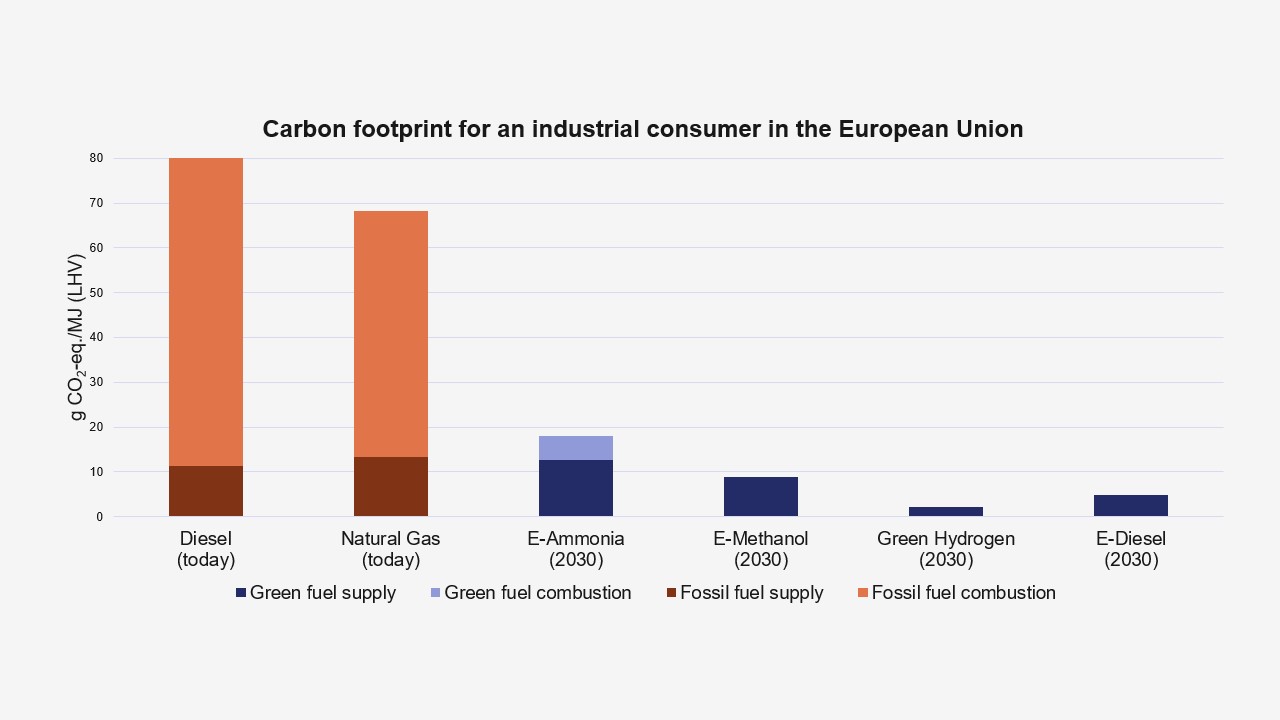The Sixth Assessment Report of the Intergovernmental Panel on Climate Change (IPCC) highlights the urgent need for serious action to combat climate change. Shifting from fossil-based to green fuel sources plays a crucial role in this.
It is increasingly clear that transitioning to green energy sources must happen fast. Key drivers of this transition are binding national and international guidelines and regulations being established for the reduction of greenhouse gas emissions and the use of green fuels (e.g. RED II/III in the EU for the use of renewable energy in different sectors; IMO Net-Zero Framework for maritime transport; ICAO-CORSIA for the aviation sector).
Furthermore, fossil fuel supply chains are becoming more vulnerable as the number of global conflicts increases, so the ability to produce carbon-neutral synthetic fuels can be crucial.
The shift to green energy production and import provides the opportunity to reduce greenhouse gas emissions, supply chain uncertainties, and meet environmental, social, and governance (ESG) requirements, all at the same time.
Green fuel production
To produce green energy, a country must be capable of generating electricity from renewable sources. This requires two things: sufficient sources like wind and solar, and physical space for the installation of electricity and fuel production facilities.
Industrialized countries, such as those in the European Union, whose limited space prevents the domestic production of green energy, will continue to import energy to a significant extent.
The following figure shows an exemplary use case for the import of fuels into the European Union. The fuel producing countries shown in the figure have excellent conditions for electricity and fuel production from renewable energies. [Note: The selection should be viewed as an example and can be expanded to include other countries.]
Transportation and import of green fuels
There are numerous options available for importing green fuels. At present, potential producers and consumers of these fuels are focusing particularly on e-ammonia, e-methanol, green hydrogen, and e-diesel.
E-ammonia is produced from (green) hydrogen and nitrogen using the Haber-Bosch process, which is a highly efficient process that has long been used on a large industrial scale. For the transportation of ammonia, a global infrastructure for the import and export of ammonia, including ammonia vessels, already exists. This enables a rapid implementation of global transport.
For e-methanol production, CO2 as feedstock is required, which is extracted from the atmosphere or from point sources. Like the production of ammonia, the production of methanol is also a widespread process that already has been scaled up industrially. The same applies to global transport.
Hydrogen is also expected to be relevant for green fuel imports. To liquefy hydrogen, it must be cooled to -253°C. For hydrogen, it is possible to repurpose existing LNG terminals and export or import green hydrogen instead of fossil natural gas. Liquid hydrogen vessels are currently under development, with the first ships expected to enter service in the next few years.
E-diesel can, particularly in sectors that are difficult to electrify (e.g. defense, agriculture, construction) enable an independent and secure fuel supply. E-diesel is produced from green hydrogen using Fischer-Tropsch synthesis, whereby CO2 is extracted from the atmosphere or from point sources.
Use of green fuels
Green fuels in the form of e-ammonia, e-methanol, liquid hydrogen, and e-diesel can directly replace fossil fuels (e.g. ammonia in the maritime sector). This is initially the case for marine propulsion systems, electricity generation, heating systems for buildings, as well as defense and agriculture applications (e.g. for large vehicles where a switch to fully electric powertrains is not feasible). Additionally, green synthetic fuels would be immediately available for other applications in industry (e.g., as feedstock for chemical products).
Environmental and economic potential of green fuels
Sphera’s sustainability consultants have investigated the switch to green fuels in numerous projects for industrial customers and in public projects. The following graphs show the potential of green fuels. For this article, we have chosen the obvious example of importing green fuels in the direct vicinity of the EU, assuming a ship transport of 2,300 km (1,429 miles). Production of green fuels is assumed to begin in 2030.
From an environmental and economic perspective, importing green fuels over longer distances (e.g., from Australia to the EU) also makes sense, even if more fuel is consumed by the transporting ship.
The values shown are based on 30+ years of LCA project expertise in the energy sector and reflect the current state of fuel supply and use in the European Union.
Sphera’s carbon footprint analyses show that under the selected conditions, all considered green fuels result in a massive carbon footprint reduction to below 20 grams carbon dioxide equivalent per megajoule (g CO2-eq./MJ) delivered fuel, compared to the fossil fuels used today.
Sphera estimates that, in 2030, renewable synthetic liquid fuels will be in a price range similar to the 2022 conventional diesel market prices. The figures from June 2022 are shown to illustrate how fossil fuel prices have already developed. These prices represent the peak for fossil fuels as a result of the war in Ukraine. Renewable electricity costs are the main cost drivers for the production of synthetic fuels. We assume these costs are in the range of around two (euro) cents per kilowatt-hour. Ship transport of liquid fuels to Europe is already very common and generates comparatively low related costs.
Many countries levy a CO2 tax on fossil fuels, and it is assumed that CO2 taxes will rise in the coming years, making fossil fuels such as natural gas and diesel more expensive in the future. On the other hand, the use of green fuels is promoted through “CO2 credits”, making these green fuels more cost-effective. With this development, synthetic gaseous fuels such as e-ammonia, e-methanol, or green hydrogen based on renewable electricity could become competitive more quickly than expected.
How Sphera can help
With more than 30 years of experience in the field of green fuels, Sphera’s Sustainability Consultants can evaluate and compare projects and technologies from an environmental and techno-economic point of view in order to promote a targeted and rapid switch to green energy supply and use.








